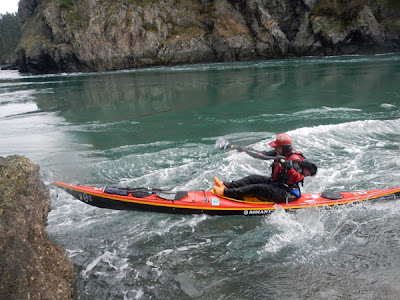 |
| Leon practicing rescue maneuvers. |
While we were on Orcas Island with Shawna Franklin and Leon Somme, we talked about the path to becoming an expert. It is, to paraphrase them, a function of hard work, deliberate practice, and guidance from a coach who offers constructive, honest feedback.
They shared with us an 2007 article from the Harvard Business Review, "The Making of an Expert" by K. Anders Ericsson, Michael J. Prietula and Edward T. Cokely, which summarizes research supporting the idea that outstanding performance is not so much a function of innate talent as it is a product of methodical, challenging practice and thoughtful, critical coaching.
 |
| Shawna challenges herself by surfing a wave while sitting on her deck. |
While we were at Deception Pass, we saw this approach in action. After allowing us to warm on an eddy line, they suggested we try increasingly challenging moves as we crossed over into the current: edging without bracing, exiting with a cross-deck rudder, returning to the eddy as quickly as possible, rolling and static bracing on the eddy line, and self and assisted rescues in the current and whirlpools. They gave different challenges to each of us, ratcheting up the difficulty as we demonstrated we were ready for more.
 |
| Seth exits an eddy with a cross-deck rudder. |
According to Ericcson, Prietula and Cokely:
- "Deliberate practice involves two kinds of learning: improving the skills you already have an improving the reach and range of your skills."
- "Genuine experts not only practice deliberately, but they also think deliberately...they continuously work to eliminate their weaknesses."
- "The development of expertise requires coaches who are capable of giving constructive, even painful feedback. Real experts are extremely motivated students who seek out such feedback."
This is true for becoming a more skillful and knowledgeable paddler as well as becoming a better coach or guide. Improvement is less a matter of innate ability than it is about willingness to work hard, seek challenges, and accept and act on knowledgeable critiques.
 |
| Alec and Sharon practicing deliberately. |
"Before practice, opportunity, and luck can combine to create expertise, the would-be expert needs to demythologize the achievement of top-level performance because the notion that genius is born, not made, is deeply ingrained." --Ericcson, Prietula and Cokely













































